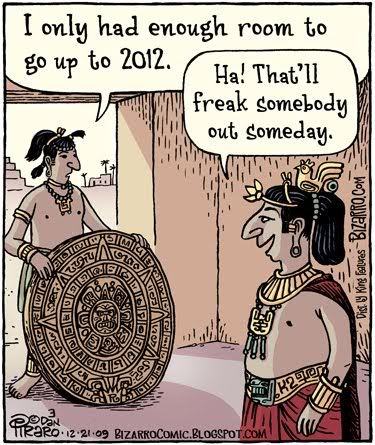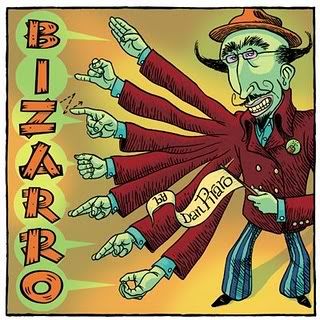Author's Note:
Comics are my favorite part of the Sunday newspaper. For this project, I chose a comic from one of my favorite comic artists, Dan Piraro creator of Bizarro. After learning how aesthetic and rhetorical techniques employed by the artist help to create an argument for everyday life through a combination of text and visual components, I have begun to look at what I once thought were created just for a good laugh.
The apocalyptic movie has become a staple within the film making industry. Fans of this genre flock to the theatres to experience the thrill and the more realistic the drama, the better. But, the most successful of these movies are the ones that create a fictional narrative based on historic artifacts or events, such as the very real 2012 phenomenon that prompted the creation of the movie, 2012. This film is based on the fears that arose as people discovered that the Mayan calendar, created some three thousand years ago, ended on the Winter Solstice of the year 2012. This arbitrary end to such an influential and superstitious culture’s calendar caused people all over the world to develop their own hypothesis for why the calendar ended on such a date. The consensus was that the Mayans knew something would happen on that exact date centuries later, causing the world as we know it to cease to exist.



The Mayan calendar depicted in the frame of the comic is an important component of the visual structure. Its historically accurate and detailed depiction proves that this image is important to the overall argument created within the comic. As shown in the image at the left, this calendar was created in a circular fashion so that there was a finite amount of room available to its creator for the time in which he (or she) was incorporating. As so eloquently said by one the characters, “I only had enough room…”. Just as the comic only had one frame to tell its story, the calendar was also limited by the finite amount of room to keep time. This analogy created between the frame of the comic and the confines of the calendar aids in the argument of misunderstanding as well as the negating of material constraints. By using a single panel of a comic, a common art form of modern culture, it helps to explain how the ancient calendar could also have been constrained by its medium in a similar manner. In other words, the comic helps to “explain the unknown by the known”. (Wysocki and Lynch 306) This relationship between the various parts of the comic is not confined to the calendar and framing.

The interaction between the inaccurate narrative and argument that the comic is working to portray is what appeals to the pathos of the audience via humor. The narrative that has been laid over the Mayan calendar in popular culture for the reasons behind the end of the Mayan calendar on the Winter solstice is that this is when the Mayans thought the world would end. The humor is held in the argument within the comic, that they actually just ran out of room on their stone to continue moving through time. They way that this message is told to the audience through slang dialect by the character’s dialogue also adds to the humor. Another part of the comic that adds to the pathos used to further the argument is the portrayal of the characters. These characters are caricatures of what actual Mayans look like. This overall comedic theme throughout the panel helps to further the argument by appealing to the pathos of the audience in an everyday and humorous way that is communicated to a variety of audiences. This type of lighthearted communication is more likely to make an audience accepting of the argument that a creator is trying to form and this is especially true with the Bizarro comic.
Many comics contain an argument, whether it is underlying or in your face. Dan Piraro, creator of the Bizarro comics, has a more ‘in your face’ style than other comic artists. In the December 21, 2009 comic, this argument is as evident as ever. The argument of this particular comic is that as a society, we tend to misread and negate the material constraints of a text and instead lay our own narrative over it that undermines the text’s original purpose and importance. This argument is created through the utilization of the aesthetic and rhetorical techniques through the use of text, visual constraints, and pathos through humor. Now it has been suggested that as a society, we tend to overlay our own assumptions on the unknown in history. Not only do comics comment on this misunderstanding, but other parts of the entertainment industry as well, in books and movies. One of the most well known historical misunderstandings that has been popularized by the entertainment industry is the DaVinci Code novels and movie series. What else in the course of history has been misread and where else in the entertainment industry has this been displayed?
Works Cited:
Piraro, Dan. Countdown to Catastrophe. 21 Dec. 2009. BizarroBlog. blogger.com, 30 Dec. 2009. Web. 28 Mar. 2010.
Wysocki, Anne Frances, and Dennis A. Lynch. Compose, Design, Advocate. N.p.: Pearson Education Inc., 2007. Print.


